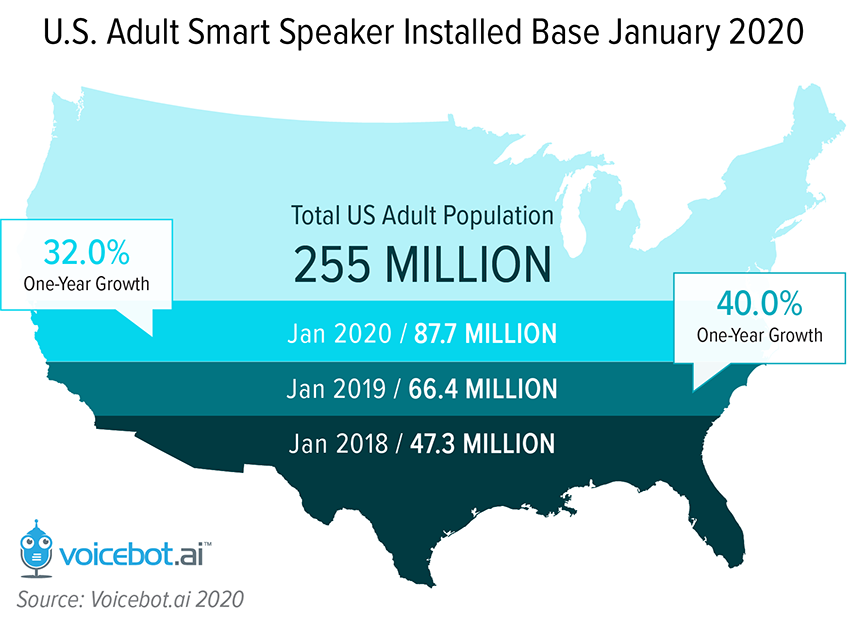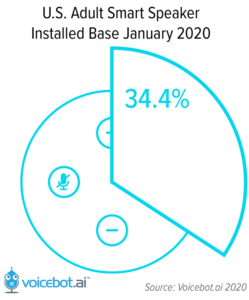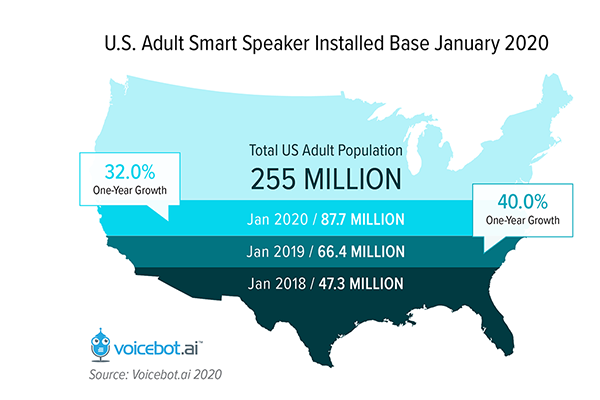Nearly 90 Million U.S. Adults Have Smart Speakers, Adoption Now Exceeds One-Third of Consumers
- The U.S. smart speaker installed user base is now 87.7 million adults, up 32% over a year earlier
- This equates to a population adoption rate of 34.4%
- Smart speaker user base growth rate slowed in 2019 over 2018 despite adding more than 20 million new users
A new consumer survey by Voicebot found that 87.7 million U.S. adults were using smart speakers as of January 2020. This means the installed base of U.S. smart speaker users is up 32% over January 2019 and is 85% higher than January 2018.
The figures do reflect a slowing relative growth rate for the smart speaker user base which was 40% in 2018 compared to 32% in 2019. However, the total number of new smart speakers owners in 2019 was actually 11% higher than the previous year. There were 21.3 million new smart speaker users in the U.S. in 2019 compared to a rise of 19.1 million in 2018.

The data are included in the newly released Smart Speaker Consumer Adoption Report 2020, the third annual report from Voicebot exploring consumer adoption and use of smart speakers. Over 1,000 U.S. adults participated in the survey which was conducted in a similar fashion as in January 2018 and 2019, enabling comparison of three years of trend data. You can download the executive summary or full report using the button below.
Download Now
Click here to see a full list of the more than 30 charts included in the report.
Installed Base of Smart Speakers Surpasses One-Third of U.S. Adults
 The addition of over 20 million new smart speaker owners in 2019 also raised the installed base of users to 34.4% of U.S. adults, up from 26.2% in 2018 and less than 20% in 2018. There is little doubt that smart speakers have been the most vital new consumer electronic device segment over the past five years.
The addition of over 20 million new smart speaker owners in 2019 also raised the installed base of users to 34.4% of U.S. adults, up from 26.2% in 2018 and less than 20% in 2018. There is little doubt that smart speakers have been the most vital new consumer electronic device segment over the past five years.
Smart speakers are also important because they represent a new interactive digital endpoint in the home that now provides access to over one-third of U.S. adults. This digital endpoint is not only available to market share leaders such as Amazon and Google, but also to third-party voice app developers.
While it is fair to say that voice assistants will continue to have larger total user bases on smartphones and in cars for some time, smart speaker owners are employing a wider variety of voice use cases and showing a higher frequency of use than the other devices. This means that voice assistants in smart speakers are more likely to have become a daily habit and are expanding consumer expectations around voice interactive experiences.
The leading smart speaker device makers will continue to push for user base expansion in 2020 but as growth rates taper, the focus will increasingly be on building loyalty through new features and cross-device integration. You can learn more by downloading the full report. Let me know what you think on Twitter.
Follow @bretkinsella Follow @voicebotai









